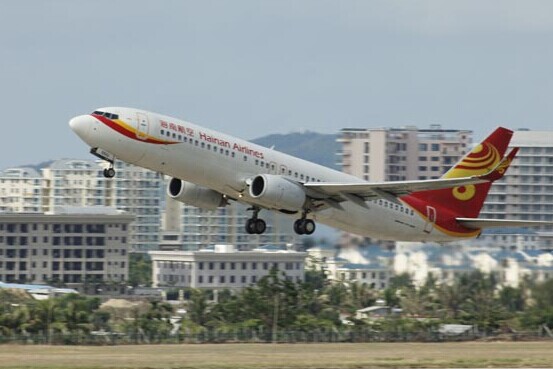

A Hainan Airlines plane takes off from Sanya, Hainan province. More and more carriers have plans to develop low-cost operations. Shi Yan / For China Daily
Chinese airlines consider low-cost options to counter pressure from rising prices and narrow profit margins
Low-cost carriers are set to fly high in China with more companies eager to cash in on rising passenger numbers and offset dwindling profits, rising costs and low profit margins.
Budget carriers are expected to clock fast growth in China in the next few years, thanks to their extremely low market share, compared with other regions, global aircraft maker Boeing Co said on Wednesday.
LCCs currently account for only 5 percent of the civil aviation market in China, compared with 27.1 percent globally, said Darren Hulst, marketing director for Northeast Asia of Boeing commercial airplanes. The low level means there is plenty of room for growth, he said.
According to Hulst, the rising demand from China will lift overall LCC capacity in the Asia-Pacific region by more than 10 percent each year. That to some extent also explains the flurry of activity in the sector recently, said industry sources.
Xia Xinghua, deputy head of the Civil Aviation Administration of China, said several State-owned and private carriers are considering LCC investments. In March, the administration released guidelines to support development of LCCs.
Although there are no unified criteria for LCCs, globally they share similar features such as cheaper tickets, lower operational costs and higher income from non-flight business.
China Eastern Airlines Ltd, the first State-owned carrier to take the budget airline route, established Jetstar Hong Kong, a low-cost joint venture with Qantas Airways of Australia in 2012. It is still awaiting final approval from the authorities.
China Eastern plans to turn China United Airlines - one of its subsidiaries based in Beijing - into a low-cost carrier. If approved, China United would become the first budget airline in the Chinese capital.
China Southern Airlines Ltd, the largest carrier by fleet, added more economy class seats on four aircraft of its subsidiary, Chongqing Airlines, early this year. Air China Ltd, the flag carrier of China, plans to transform one of its subsidiaries into a low-cost airline soon, industry sources said.
HNA Group, the parent company of Hainan Airlines, the fourth-largest carrier in China, already has two low-cost subsidiaries - West Air and Hong Kong Express - with other subsidiaries working on cutting costs.
"All our subsidiaries will be low-cost carriers, and Hainan Airlines will be the only full-service carrier," said Wang Yingming, executive chairman and executive president of HNA Aviation Holding Co Ltd.
According to Wang, most of the big carriers are maintaining a low profile about their LCC operations as the transformation is not complete and there are still some uncertainties.
Unlike the State-owned carriers, private airlines are more vocal about their LCC operations.
Jiuyuan Airlines, a Guangzhou-based low-cost subsidiary of Shanghai Juneyao Airlines Co Ltd, got the final approval from the authorities in February and plans to start flights in August.
The new carrier also made the largest aircraft purchase by a private Chinese airline, by purchasing 50 aircraft worth more than $6 billion from Boeing.
China Express, a regional carrier connecting southwest regions, also moved to low-cost operations with some tickets ranging from 8 yuan ($1.30) to 188 yuan in May. Wu Longjiang, president of China Express, said its fleet of small aircraft is cost-saving and connects a network of small cities, where demand for budget airlines is high.
"Market demand has played a big role in fueling demand for LCCs," said Wang from HNA Aviation. Low profit margins and rising fuel and human resource costs are driving the shift to LCCs, he said.
Although fuel prices have risen steadily, carriers cannot raise ticket prices due to stiff competition, Wang said, adding that the real challenge for most carriers is to maintain profitability.
The total profit of Chinese carriers was 16.24 billion yuan last year, 3.72 billion yuan less than the previous year, while their operating income increased by 5.2 percent during the same period, according to CAAC.
The high profitability of LCCs is an attractive option for most carriers, said Li Xiaojin, a professor at China Aviation University based in Tianjin.
However, most of the companies still have to sort out several issues before taking the LCC route for growth, he said.
The profit is not just dependent on cost but also on the load factor, Li said, adding that low-cost carriers need higher load factors than usual, as their ticket prices are low.
The carriers have to try their best to attract enough passengers to fill every flight, he said, and that is why Spring Airlines, the largest budget carrier in China, launches promotional events frequently.
Passengers' acceptance and government policy also play a major role in the profitable operations of budget carriers, industry sources said.
Though a low-cost airline, West Air still provides some additional services, such as free in-flight meals and free luggage check-in, because passengers are used to such services, said Cen Jianjun, vice-president of West Air.
Current regulations also do not provide enough room for carriers to cut costs on aircraft and other material purchases, fuel charges and other fees.
"Low-cost carriers still have a long way to go in China, but they will certainly take off," said Wang.
Copyright ©1999-2018
Chinanews.com. All rights reserved.
Reproduction in whole or in part without permission is prohibited.